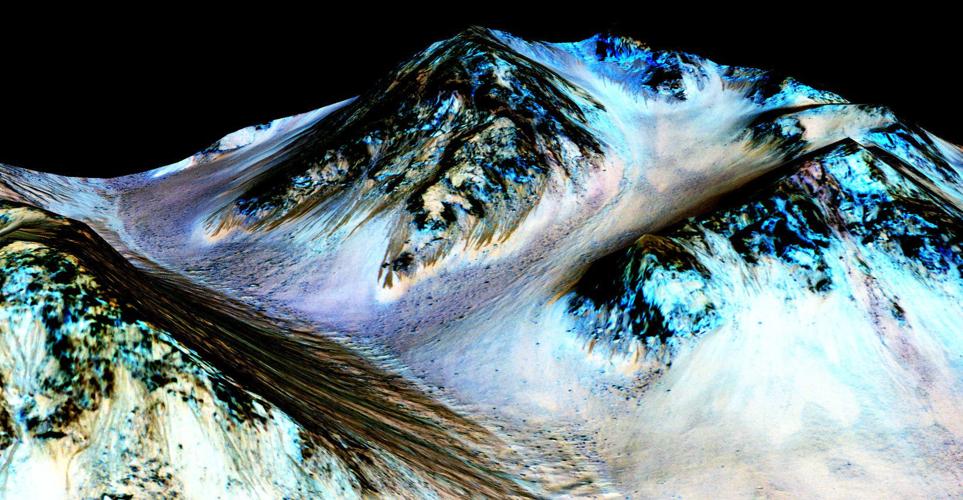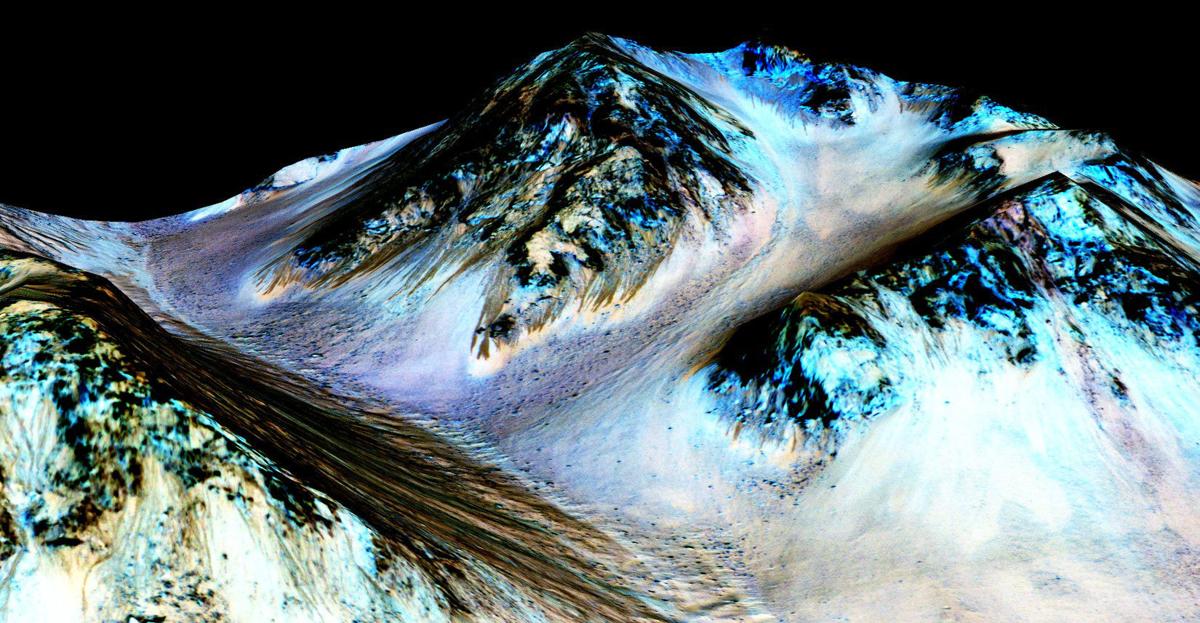Water flows on Mars. It’s salty and ephemeral but it is flowing, NASA scientists say.
NASA announced Monday that ongoing observations, using instruments aboard the Mars Reconnaissance Orbiter, confirmed earlier studies by scientists at the University of Arizona, who found the flows on images taken by NASA’s HiRISE camera.
“It suggests,” said former astronaut John Grunsfeld, “that it would be possible for there to be life today on Mars.”
Grunsfeld, associate administrator for NASA’s Science Mission Directorate, said he wore his astronaut jacket to the press conference to underscore that findings like these demonstrate that “science will lead the way” to human exploration of the red planet.
Lujendra Ojha, lead author of a paper published Monday in Nature Geoscience on the results, said the paper concludes that water does flow seasonally on Mars, but was circumspect about any meaning behind that.
Water is a critical ingredient for life on Earth, he said, “but just because we find it there doesn’t mean life exists. We need to be more modest about our results.”
Ojha spoke by telephone from Nantes, France, where he is presenting his results at the European Planetary Science Conference, along with one of his co-authors — Alfred McEwen, who directs NASA’s HiRISE camera observations of Mars from the University of Arizona Lunar and Planetary Lab.
Ojha and McEwen also participated by phone at a Monday NASA news conference on the results.
Ojha was an undergraduate student at UA when he first discovered seasonally occurring lines on the planet’s surface that indicated there might be water flowing down slopes. Those results, published in August 2011 in the journal Science, proposed extremely salty water as an explanation.
Continuing observation of the “recurring slope lineae” or RSL by HiRISE and an imaging spectrometer called CRISM detected the spectral signature of a group of salts known as perchlorates.
The salts make it possible for water to flow at temperatures well below freezing, Ojha said.
“When most people talk about water on Mars, they’re usually talking about ancient water or frozen water,” he said. “Now we know there’s more to the story. This is the first spectral detection that unambiguously supports our liquid water-formation hypotheses for RSL,” Ojha said.
The salts were detected by the spectrometer on board NASA’s Mars Reconnaissance Orbiter in a variety of spots, but only when the seasonally occurring lines had widened. That corresponded with warming temperatures in those regions.
“They follow the sun,” said McEwen. The slopes are active in the season that region is getting the sun,” he said.
Grunsfeld said the findings support the need for continued investigation of the presumed water flows by HiRISE and the Mars Reconnaissance Orbiter.
McEwen said at the NASA news conference that he has always suspected Mars would harbor life of some sort. “I would just say that the possibility of life in the interior of Mars has always been high. Now, maybe, there is something we can find on the surface.”
Lujendra, now a graduate student at Georgia Tech’s School of Earth and Atmospheric Sciences, said he divides his time these days between space missions and terrestrial research.
He is working with the team of the InSight (Interior Exploration using Seismic Investigations, Geodesy and Heat Transport) NASA Discovery mission to study “Marsquakes” and teaming up with geoscientists, including his father, to study the frequency of earthquakes in the higher Himalayas, where 10,000 people died in April’s earthquake around his home town of Kathmandu.
If you want to understand the forces that shape planetary evolution, you can’t study just one of them, he said.
“To understand Mars, we need to understand our own planet. When we combine our understanding of Earth with Mars, it’s just that much better,” Ojha said.







